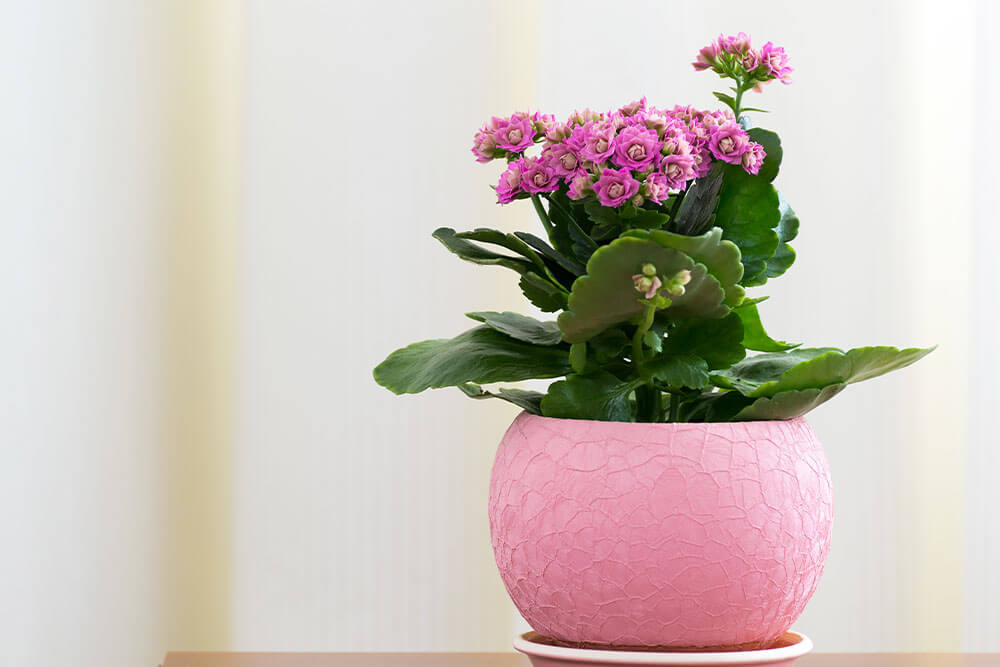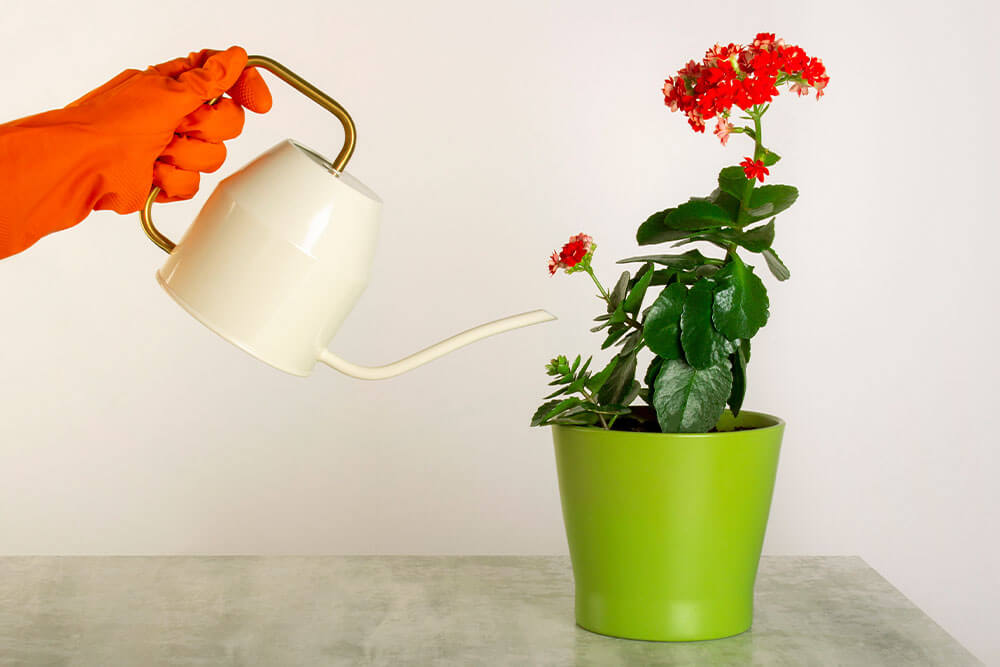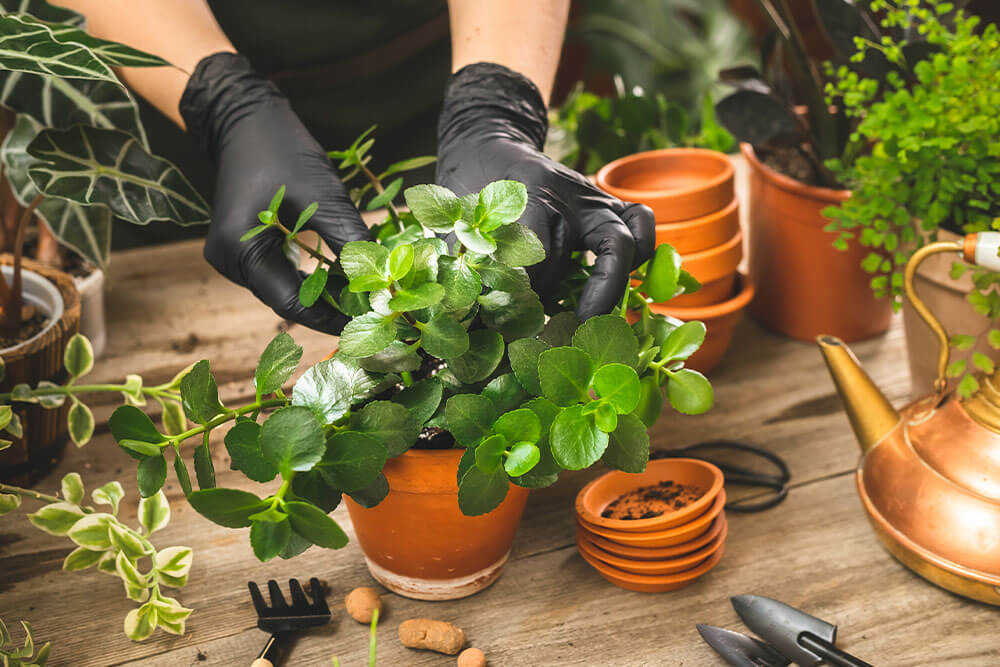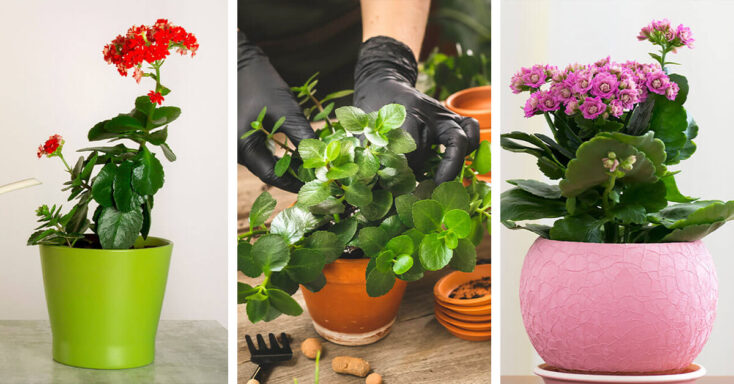Kalanchoe is a plant originating in Madagascar. When left to its own accord, it can grow 20 feet tall. Thankfully for indoor gardeners, most species don’t get bigger than 3 feet. The leaves on this plant are fuzzy and oblong. When it blossoms, red, orange, pink, or yellow clusters appear. The flowers are long-lasting, often over 8 weeks from beginning to end, making the plant very popular. Learn everything about Kalanchoe care in this guide!
Key Takeaways
- You can grow Kalanchoe indoors or out. If you put it outside, it will need a safe haven before the first frost.
- Use succulent or cactus soil for planting and replanting Kalanchoe.
- Purchase a clay pot for this plant. It will wick excess moisture from the soil, helping deter root rot.
- The indoor Kalanchoe can blossom year-round with proper coaxing.
Knowing Kalanchoe
Kalanchoe resembles some other plants. But there are ways you can identify it. First, it has succulent, toothed leaves. Flower tubes are slender, and the lobes spread flat. Each has four petals. Some clusters have a central stem on which they’re poised. Others have equal-length stalks emerging from a common center (akin to parsley).
If you have a succulent indoor garden, these make a great addition. It’s possible to train Kalanchoe as a climber or let it be as an herb. They don’t need a lot of water. When the flowers produce seeds, collect them. You can propagate many plants from your harvest.
There’s no question that “Kalanchoe” is a mouthful. What other nicknames does this plant have? They include Flaming Katy, Madagascar Widow’s Thrill, Mother-in-Law Plant, and Mother of Millions.
Indoor Kalanchoe Care
There are five key points to indoor Kalanchoe care:
- Consistent bright, indirect light. Full sun can harm the plant (you’ll notice browning tips). If you notice your plant becoming leggy, it needs a sunnier location.
- Well-drained, sandy soil. If you cannot find a cactus mix, use 60 percent potting soil to 40 percent perlite.
- Provide minimum water every few weeks. If you’re a busy person, Kalanchoe will forgive you if you miss a watering (they store moisture in their leaves). The soil should dry completely between waterings.
- If the temperatures in your home remain between 55 and 80F, Kalanchoe will get on just fine. Avoid placement near air conditioner ducts. Also, if your plant is in front of a window, check for drafts come winter. Turn it every few weeks so it gets light and warmth on all sides.
- Kalanchoe has a moderate appetite. Use a blanched fertilizer in spring and summer, stopping come winter. If you aren’t getting flowers, look for a soil mix that’s higher in phosphorus.
Kalanchoe as a Curative: Kalanchoe appears in traditional medicine as a treatment for inflammation and infections. The extract of Kalanchoe has immunosuppressive effects. The people of Trinidad use Kalanchoe pinnata as a hypertension remedy. Some compounds from this plant act as sedatives.

Indoor Kalanchoe Needs
You will not have to fuss much over your Kalanchoe plant. So long as you give it a well-drained medium to live in, it’s typically pretty healthy. Pot gardening makes drainage easier because it’s geared toward drainage and moisture control. Wait for your plant’s soil to dry completely before adding more water.
This plant wants a warm, cozy location in your house. Look for an area with filtered light, making sure it’s protected from the noon-day sun.
Fertilize Kalanchoe once a month throughout spring and summer.
As your kalanchoe grows, it will produce offsets. These can tax your plant’s energy. So rather than let them continue to do so, you can snip them off. Cut at the point where it connects to the mother plant. Let the end dry until it has a callus. Dip that part of the clipping in rooting hormone. Now, just plant it into the same type of soil as the mother plant. Do not water it for one month. Afterward, you can care for it the same way as your mature plants.
Indoor Kalanchoe Choices
There are several species of Kalanchoe you can consider for adding to your indoor landscape.
- Alligator Plant: Also known as the Mother of Thousands, this Kalanchoe has tiny string pearl-like growths along its edges. When each falls to the ground, a new plant grows. An excellent choice for beginners.
- Beach Bells: Beach bells have fleshy leaves and produce downward-pointing, bell-shaped flowers. The plant reaches 16” tall. When the sun is bright, the 1-inch green leaves turn reddish, matching red-orange petals.
- Cathedral Bells (Life Plant; Miracle Leaf): Cathedral bells grow to be about 3 feet tall. The followers maintain a pink-red tinge throughout most of the year. It creates miniature plantlets that fall to the ground and root.
- Felt Bush: Indoors, the felt bush can grow four feet tall. Felt Bush has lance-like triangular leaves. Each leaf is about 4 inches long. The underside is smooth and green. The top has brownish wooly hairs.
- Chandelier Plant: The chandelier plant receives its name based on how orange tubular flowers hang down from stem tops. Full size 4 feet tall x 2 feet wide.
- Flapjack (Paddle Plant): As the name implies, this kalanchoe has flat, round leaves. Average height and width 2×2 feet. During cooler months, the tips of the leaves turn reddish. The flowers grow on one 2-3’ stem bundled together in yellow.
- Mexican Hat Plant: If you look at this kalanchoe, you may notice plantlets on the leaf. margins. The top of the 8-inch long leaf is green, while the underside has purple blotches. Flowering is rare.
- Panda Plant (Chocolate Soldier): The leaves have a pulpy blue tinge and a velvet fuzz. There are brown spots appearing all along the edges of the foliage. It grows to about 18 inches but rarely blossoms indoors.
- Pearl Bells: Pearl Bells have thin, rectangular leaves and purple pendant flowers that look like elongated paper lanterns. Grows just over a foot tall.
- Velvet Leaf Plant (Elephant’s Ears, Teddy Bear, Napoleon’s Hat): This Kalanchoe has large fuzzy leaves tinted in silver-green. Height at maturity: 3-5 feet.
Kalanchoe Versatility: These plants can be trained to climb, remain a shrub, or even appear as an herb. If it flowers, which sometimes is difficult indoors, the flowers are long-lasting. Some species grow plantlets at their leaf edges, each of which can grow into a new flower. If you’d like some outdoors, you can overwinter them inside with little trouble. Kalanchoe are drought resistant.
Watering Indoor Kalanchoe

As succulents, these plants require less frequent watering. In fact, let the soil dry out completely between waterings. On average, this translates to once every 2-3 weeks. If it goes a little longer, it shouldn’t harm anything.
It’s best to water the kalanchoe from the bottom of the plant. Keeping upper leaves dry helps avoid certain dampness-driven diseases. Even with good timing, your plant can develop root rot. Getting a well-drained potting mix and a container with several drainage holes is a proactive means of management. You do not have to mist it, but you can do so if you’re removing dust and debris. It doesn’t hurt to give your plant a light wash once a month since dust impedes photosynthesis.
WARNING: All parts of the Kalanchoe plant are toxic to cats and dogs. Place your plants accordingly.
Potting and Repotting Indoor Kalanchoe Plants
The process of potting your plant when you get it home from the nursery and that of repotting are pretty much the same with but a few differences. With established plants, it’s best to repot in the fall after the flowers die off.
After a few (about 2) years, you’ll notice the mature kalanchoe’s roots trying to sneak through the bottom of their current pot or peeking above the soil. Since Kalanchoe does not like being rootbound, it’s time to act. At this point, you want to go up one size from the current container (by 1” in diameter). Since these flowers aren’t fast growers, you won’t have to repot terribly often.
For the potting and repotting process, the first step is loosening the plant from its current home. Put down some newspaper and lay the plant on one side. Keep one hand on the container and the other at the base of the plant and wiggle gently. Clear off the excess dirt as much as possible.
If the roots look overcrowded, gently spread them out. Prepare a new crock, filling it 1/2 the way up with brand-new soil. Put in the Kalanchoe and backfill the remaining soil around it. Give it some water, and find a sunny location.
Within the first few weeks, your plant may look a little lackluster. Don’t worry. It’s just in shock from the change. Keep tending it carefully, and it will perk right up.
In China, Kalanchoe bears the name “wan zi gian thong.” This means Mother of Millions. The reference comes from the fact that these plants create tiny blossoms that last for months. The people of China associate Kalanchoe with prosperity and good fortune because of its bright flowers. If given as a gift at New Year’s, it brings improved luck.
Indoor Kalanchoe Pruning and Maintenance
The Kalanchoe Plant benefits from pruning and maintenance. If you get blossoms, make sure to pinch them off as soon as they’re spent. The heads don’t look pleasant, and getting rid of them encourages a new bloom.
Once the flowers are off, cut back the stalks. Look to the area around the second or third leaf. Don’t go any further. Your plant will grow fuller for the effort.
When your kalanchoe gets leggy, you can prune it and get it into an area with more light. Remove brown, yellow, or decaying leaves at their base (where it meets the stem). Cut back broken or damaged parts, too.
Tip: Always cleanse your cutters after pruning. So doing this deters the chance of spreading disease. Rubbing alcohol works well.
Kalanchoe Symbolism: People sometimes buy this plant on Valentine’s Day to represent romance and enduring love. In the Language of Flowers, it’s an emblem of persistence, continuation, and fortitude. The pink Kalanchoe is a flower of friendship and gratitude. Yellow suggests good look and cheer. Orange is the color of optimism, zeal, and joy.

Kalanchoe Blooming and Resting Periods
If you have outdoor kalanchoe, you want to bring them inside before the threat of frost (when the temperatures consistently fall below 55F). When it reaches 45F, your plant can begin experiencing damage. Beyond USDA Hardiness Zones 9-11, you’re best to move the plants.
Indoor care is fairly straightforward. Keep your plants in a sunny area with indirect light (like a west-facing window). If you don’t have enough natural light indoors, look to grow lights. As a general rule, your plants won’t need as much water during winter.
What about blooming? The Kalanchoe responds to 14 hours of darkness in winter (four months). Come spring, the plants require bright indirect sunlight to start blooming. If you have the right light, they will continue throughout much of the year. Without ample sun, blossoms simply won’t happen.
Don’t get frustrated if your indoor kalanchoe doesn’t flower. It’s somewhat rare. They’re more likely to blossom outdoors.
Originally, you could find Kalanchoe tucked away in exotic Southeast Asia, southern Africa, and Madagascar. It was 1930 when Robert Blossfield, brought them to Europe. Fast forward to 1971. Kalanchoe went into space on the Soviet Salyut 1 space station.
Common Pests & Plant Diseases
Your indoor Kalanchoe will rarely experience problems. Usually, issues stem from too little or too much water instead of other causes. Without proper drainage, they’ll develop root rot.
They may experience Powdery Mildew. Leaves appear mottled, often yellow. Or there may be dead flecks and red circular wounds. Powdery Mildew stunts a plant’s growth. The best prevention is having good airflow around your Kalanchoe. Make sure to clean off affected parts and dispose of them.
In terms of insects, your plants may experience brown scales, aphids, or mealy bugs, three of the most common bugs appearing on household plants. You can remove the insects using an alcohol swab or treat the kalanchoe with Neem.
Inside Out: One of the more interesting characteristics of Kalanchoes is the way in which cells grow. They have new cells developing on the interior of petals to manifest flowers. These same cells grow outside the petals, helping them to close.
Troubleshooting Common Problems
Even easy-to-grow plants can experience problems. Over time, some patterns emerge. Common issues showing up showing up in Kalanchoes are:
- Damaged blossoms and leaves: This happens when the plant gets too cold. Check around to see if it’s getting a cold draft from somewhere.
- Wilting: High temperatures can cause this. Keep them below 80F. The plant may, alternatively, need water.
- Burnt or drab leaves: Bright, direct sunlight will burn their leaves. Too little light and the plant’s leaves lose their gloss.
- Fragile stems: A sign of over-watering.
- Failure to bloom: Not enough winter darkness (they need 6 weeks of 14 dark hours daily).
Frequently Asked Questions About Indoor Kalanchoe
Is Kalanchoe indoor or outdoor?
Actually, it can be both. Outdoors, Kalanchoe grows much larger. However, they are temperature-sensitive. So, if you live in a cooler climate, look to growing this plant indoors. The Hardiness Zone for most Kalanchoes is 10-12. During warm months, you can always give your plant an outdoor adventure. Just be aware that it exposes them to more potential insect issues.
How often do you water a kalanchoe?
Rather than guessing, use one simple trick to see if your plant needs water. Put your finger into the pot two inches down. The soil needs to be dry before you add moisture. They only need water every 2- weeks, so when you pass through the house, stop and give them a check.
Do Kalanchoes like full sun?
If you’re wondering where to put your indoor kalanchoe, the answer is in an area where it gets dappled light (no noonday sun). South-facing windows are fine so long as there is some shady. Western windows may prove better. As they receive warm sunlight, the more likely they are to bloom.
Will Kalanchoe survive winter?
It depends heavily on where you live. If temperatures drop to 45F, your plant can die. At this point, bring them indoors (well before the chance of a hard frost). A softer frost may just cause Kalanchoe’s foliage to die back.
How long does Kalanchoe last?
The flowers of the Kalanchoe remain for up to 8 weeks, which endears them to many. These plants live for about seven years.
Summary
Kalanchoe is a plant that beginner gardeners can wrangle. It’s really just a matter of paying attention to water, light, and drainage to achieve success. They make a pretty and striking addition to the indoor landscape. The overall appearance of Kalanchoe doesn’t deter from any other plants in your household garden. They can take center stage,or work as a backdrop, depending on your vision for the end result.


